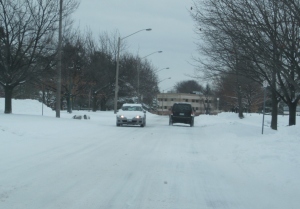For drivers, what IS considered normal?
 One of the common questions I’ve been asked by students I’m teaching at Young Drivers of Canada is “What is normal?” It seems to be a simple question, doesn’t it? I’ve answered it as ‘the same as always’ or ‘routine’. How often is something referred to as being normal compared to not normal? Do you recognize when things would be considered “not normal” when you’re driving?
One of the common questions I’ve been asked by students I’m teaching at Young Drivers of Canada is “What is normal?” It seems to be a simple question, doesn’t it? I’ve answered it as ‘the same as always’ or ‘routine’. How often is something referred to as being normal compared to not normal? Do you recognize when things would be considered “not normal” when you’re driving?
Speed limits on roads are determined for when the conditions are considered to be normal; on dry roads with good visibility. When these conditions aren’t met, why drive the same as you would when the conditions are normal?
We recently had our first snowfall and as expected, drivers lost control of their vehicle and crashed. If conditions are not normal, we need to learn to adjust. With the snowy and somewhat icy conditions, the drivers need to drive at a slower rate of speed. If drivers can also create space beside their vehicle they can have space to move into if they need to avoid something or someone. If the conditions are bad enough, get off the road and stop driving.
Driving at night has the same issues. The speed limits are set for ideal conditions. If that’s the case, why drive the speed limit when you can’t see as far ahead when it is dark compared to when it’s light outside? Overdriving your headlights is a common thing that many drivers do, but probably aren’t aware of it. Overdriving your headlights means that you’re driving faster than you’re able to see and respond. A simple solution again is to reduce speed.
We’ve had a lot of fog in our city recently and because of that, I saw the safe driving conditions being reduced significantly. However, drivers continued to drive at freeway speeds even though their visibility was only a few seconds ahead of their vehicle. Why didn’t they slow down? Why were they even driving on the freeway with this poor visibility anyway?
How many times have you driven the speed limit – or faster- during a heavy rainstorm? Wasn’t your visibility reduced compared to normal conditions? If so, why were you driving as fast as you were? Not only would your visibility be reduced, your traction is also reduced, which means you’ll need more time to stop. If that’s the case, it’s also time to slow down and increase your following distance. Why drive the same way when conditions aren’t normal?
As a smart driver, we need to learn to think ahead of time and to always think like a driver. If the conditions aren’t considered to be normal, make the necessary changes to remain safe. Perhaps even part of those changes means you shouldn’t drive at all. Making these driving choices should be considered normal to safe drivers.
In Seattle, it’s normal for drivers to only slightly alter their driving behavior in the dark or rain. However, it is perfectly normal for just about the entire state to shut down if there is an inch or two of snow.
Shutting down with snow may be better than driving in conditions you’re unfamiliar with or nervous with. Thanks Bridget.
This is a very important point to stress, especially for young people. Our cars may be getting safer, but we won’t be as protected if our habits aren’t improved!